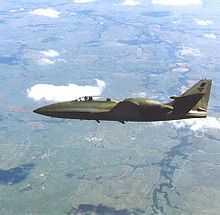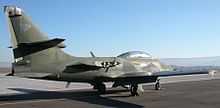Boeing Skyfox
The Boeing Skyfox was a twin-engined jet trainer aircraft, a highly upgraded development of the Lockheed T-33. It was designed as a primary trainer to compete with and replace the Cessna T-37 Tweety Bird.[1] Besides its primary role as a trainer, the aircraft was envisioned to have other roles as well, including ground attack. The program was started by the Skyfox Corporation in 1983, and was acquired by Boeing in 1986.[2]
The program included the replacement of the Allison J33-A-35 turbojet by two Garrett TFE731-3A turbofans. It also included an extensive redesign of the airframe. Only one prototype aircraft was built, and the program was later canceled due to lack of customers.[3]
Design and development
Over 6,500 Lockheed T-33 trainers were built, making it one of the most successful jet trainer programs in history.[4][5] However, technology passed the "T-Bird" by, and by the 1980s, it was clear that the world's air forces needed a more modern training aircraft. The "Skyfox" was conceived and developed by Russell O'Quinn. The modification designs were led by T-33 designer Irvin Culver and a number of other former Lockheed employees formed Flight Concepts Incorporated in 1982, with the intent of modernizing the T-33 design. The company's name was later changed to Skyfox Corporation.[2]
The highly modified and modernized aircraft was expected to cost about half of a new comparable trainer, such as the British Aerospace BAE Hawk and the Dassault/Dornier Alpha Jet. With the design work done, Skyfox purchased 80 surplus T-33s.
The Skyfox was marketed either as a complete converted aircraft from Boeing, or as a conversion kit, with the customer providing the T-33 airframe. The conversion incorporated about 70% of the existing T-33 airframe, but replaced the existing internal single Allison J33 turbojet engine with two Garrett TFE731-3A turbofan engines mounted externally. Together, the two TFE731s weighed 17% less than the single original engine, provided 60% more thrust on 45% less fuel.[6]
The engine change provided a large internal volume for fuel storage, eliminating the need for the T-33's tip tanks, but tip mountings were retained to accommodate optional auxiliary fuel tanks if desired.
Other modifications included inboard wing leading-edge extensions, the replacement of the tip tanks with winglets, new canopy with one-piece windshield, revised nose geometry to improved visibility from the cockpit and to fair into the T-33's lateral intakes, new tail surfaces with a mid-set tailplane, although the original wings were retained, and new avionics.
Conversion options



The Skyfox was designed to be produced entirely from kits of components. The conversion involved the disassembly, the inspection, and the refurbishment of the T-33 airframe as necessary, the installation of the kits and reassembly of the airframe in the Skyfox configuration.[3]
There were two conversion options: to purchase a complete Skyfox from Boeing or to purchase a conversion kit from Boeing and perform the conversion in the country itself.
The standard conversion kit included:
- Two Garrett TFE371-3A turbofans, the nacelles, and the propulsion support system.
- Nose and tail assemblies.
- Single-point refuelling.
- Aerodynamic refinement kit.
- Structural refinement kit.
- Nose wheel steering.
- Anti-skid power brakes.
- Single-piece windscreen.
- Hydraulic components kit.
- Generator control and distribution system.
- Throttle quadrants and control system.
- Fire extinguishing system.
Plus control panels for the cockpit
In addition to the standard conversion kit described above, Boeing also offered a number of options that could further improve the overall capability of the Skyfox:
- Avionics upgrade.
- Basic rewiring of the aircraft.
- Tactical, reconnaissance, and electronic warfare (EW) training mission packages.
- Zero-zero ejection seat.
Operation and support costs
The operating and support costs of the Skyfox were less than that of the T-33 and could compete with the costs of the Hawk and the Alpha Jet. Structural improvements, avionics upgrades, electrical rewiring, airframe and systems refurbishment, and powerplant modifications resulted in low cost, low maintenance hours and low spare parts consumption.[3]
The two TFE371-3A turbofans that powered the Skyfox together weighed 17 per cent less than the single J33-A-35 turbojet of the T-33, while producing 60 percent more thrust and consuming 45 percent less fuel. The TFE371-3A turbofan had a ten-fold increase in time between overhauls (TBO) compared with the J33-A-35 turbojet. The result was a greatly improved maneuverability, range, endurance, payload and the added overwater and hostile terrain safety of the twin powerplant configuration.[3]
Potential customers
Portugal
To replace the T-33A, Portugal signed a letter of intent with the Skyfox Corporation in the middle of the 1980s for 20 conversion kits. The Força Aérea Portuguesa (FAP) proposed that Oficinas Gerais de Material Aeronautico (OGMA) in Alverca would undertake the conversions, but insufficient orders were obtained from other nations to motivate Boeing to continue with the project.[7]
USA
Even the USAF was interested in the Skyfox.[citation needed] It was originally planned to demonstrate the Skyfox at Farnborough International 1986, but the aircraft was tested at the time by the USAF. Eventually, the USAF did not purchase the Skyfox.
Operational history
The first Skyfox converted was an ex-Canadian Forces CT-133, the Canadian license-built equivalent of the T-33 which were formerly a Silver Star 3AT (Armament Trainer). This particular aircraft was produced in 1958, had construction number T.33-160 and serial number RCAF21160.[8] It was struck-off charge on 10 November 1970 and was sold through Crown Assets Disposal Corporation to Leroy Penhall/Fighter Imports in 1973. It was then sold to Murray McCormick Aerial Surveys in 1975. Its next owner was Consolidated Leasing in 1977.[8]
The Skyfox was sold to the Skyfox Corporation, carrying the U.S. civilian registration number of N221SF, on 14 January 1983 and went to the Flight Test Research in August 1983.[9] After conversion to the Skyfox configuration it flew its first flight as the Skyfox prototype on 23 August 1983, nearly 35.5 years after the first flight of the T-33. Race and test pilot Skip Holm performed the initial flight test at the Mojave Airport, California. The Skyfox prototype was white overall, with black cheat lines, and a very pale blue trim.
The Skyfox Corporation was not able to find any buyers for the aircraft, despite its price and capability. However, in 1986, Boeing Military Aircraft Company saw potential, and purchased the marketing and production rights. Even though Portugal signed a letter of intent for 20 conversion kits, no other nation signed on, and faced with a lack of customers, Boeing cancelled the project. The prototype aircraft remains the only Skyfox built. As of June 2008, the prototype is parked on the flightline at Rogue Valley International (MFR) in Medford, Oregon without engines.
Specifications
Data from Airwar Specifications[10]
General characteristics
- Crew: 2
- Length: 13.41 m (46 ft)
- Wingspan: 11.83 m (38 ft 10 in)
- Height: 3.76 m (12 ft 4 in)
- Airfoil: NACA 65-213
- Empty weight: 3,856 kg (10,284 lb)
- Loaded weight: 6,532 kg (14,400 lb)
- Max. takeoff weight: 7,364 kg (20,000 lb)
- Powerplant: 2 × Garrett TFE731-3A turbofan, 3,700 lbf (16.5 kN) each
- Fuel capacity:
- Internal fuel capacity: 3,191 litres
- Total fuel capacity: 4,932 litres
Performance
- Range:
- Service ceiling: 40,000 ft (12,192 m)
- Rate of climb: 4900 ft/min (1,494 m/min) at sea level. (985 ft/min [300 m/min] at altitude)
- Fuel consumption: 23.3 mg/(N·s).
A total of 2,700 kg of armament on 10 underwing hardpoints.
| T-33A Shooting Star | Boeing Skyfox | |
|---|---|---|
| Empty weight | 15095 lb (6,847 kg) | 16235 lb (7,364 kg) |
| Rate of climb at Sea Level | 3,400 ft/min (1,036 m/min) | 4,300 ft/min (1,490 m/min) |
| Time to 9,144 m | 15 min | 8 min and 12 sec |
| Operating range | 2,315 km | 3,630 km (Internal fuel) 4,815 km (Internal and external fuel) |
| Operating endurance | 2 hours | 5.1 hours (Internal fuel) 7 hours (Internal and external fuel) |
| Takeoff distance | 4,600 ft (1,402 m) | 2,600 ft (793 m) |
See also
- Related development
- Aircraft of comparable role, configuration and era
References
- Notes
- ↑ "Skyfox." tv-series.com. Retrieved: 15 July 2011.
- ↑ 2.0 2.1 "American airplanes: Sk - Sp." Aerofiles. Retrieved: 15 July 2011.
- ↑ 3.0 3.1 3.2 3.3 "Boeing Skyfox". Retrieved 21 December 2008.
- ↑ Baugher, Joe. "Lockheed TP-80C/TF-80C/T-33A." USAF Fighters, 16 July 1999. Retrieved: 15 July 2011.
- ↑ "Lockheed T-33 'Shooting Star'." Warbird Alley. Retrieved: 15 July 2011.
- ↑ "Military aircraft: Skyfox." highgallery.com. Retrieved: 15 July 2011.
- ↑ Huertas 1996, p. 152.
- ↑ 8.0 8.1 "CT-33/RCAF21160." Warbird Registry. Retrieved: 15 July 2011.
- ↑ "N221SF." FAA Retrieved: 15 July 2011.
- ↑ "Skyfox Specifications." Airwar. Retrieved: 15 July 2011.
- Bibliography
- Air Classics, Volume 19, Number 11, November 1983.
- Aviation Week & Space Technology, 23 May 1983.
- Aviation Week & Space Technology, 29 August 1983, p. 23.
- Aviation Week & Space Technology, 26 September 1983.
- Aviation Week & Space Technology, 5 March 1984, pp. 39–46.
- "Boeing Skyfox: National Defense." Boeing Military Airplane Company, 1987.
- "Boeing Skyfox: Tactical Modernization at Low Cost." Boeing Military Airplane Company, 1987.
- Donald. David and Jon Lake, eds. Encyclopedia of World Military Aircraft. London: Aerospace Publishing Limited, United Kingdom, 1996. ISBN 978-0-7607-2208-4.
- Flight International, 13 December 1986, pp. 32–34.
- Francillon, Rene J. Lockheed Aircraft since 1913. Annapolis, Maryland: Naval Institute Press, 1988. ISBN 978-0-87021-897-2.
- Francillon, Rene J. "T-bird at fifty." Air Forces Monthly, Number 124, July 1998. Stamford, UK: Key Publishing Limited.
- Huertas, Salvador Mafé. "Portugal: Air Power Analysis". World Air Power Journal, Volume 24, Spring 1996, pp. 148–157. London: Aerospace Publishing. ISBN 1-874023-66-2.
- Lambert, M., ed. Jane's All the World's Aircraft 1990-91 (Eighty-first edition). Surrey, UK: Jane's Information Group Limited, 1990.
- Meppel, Ten Brink and B.V., Meppel. "Skyfox - Een moderne trainer voor de smalle beurs." Luchtvaart (the Netherlands), 3de Jaargang, Nummer 11, November 1986, p. 308.
- Rankin-Lowe, Jeff, Andrew Cline and G. Scott Clements. The Aircraft of the Canadian Armed Forces"a Checklist of Current Aircraft and Disposals. Toronto: Sirius Productions, Second Edition, 1998. ISBN 1-896103-00-6.
- "Skyfox." Boeing Military Airplane Company, October 1987.
- Swanborough, Gordon and Peter M. Bowers. United States Military Aircraft Since 1909. Washington, DC: Smithsonian, 1989. ISBN 978-0-87474-880-2.
External links
| Wikimedia Commons has media related to Boeing Skyfox. |
| ||||||||||||||